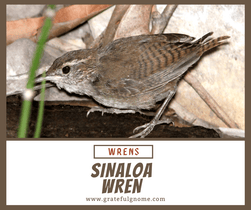Red-legged Thrush
The Red-legged Thrush, a bird of the West Indies is a thrush species often associated to the American Robin because they have similar behavior and they often live near human habitations.
Field Sparrow
The Field Sparrow is a small sparrow that resembles the American Tree Sparrow. It can be either gray or buffy overall, with white eye-ring and pink bill.
Sinaloa Wren
The Sinaloa Wren, formerly known as the "Bar-vented Wren" is a small skulking wren of lowlands and foothills in west Mexico.
Mistle Thrush
The Mistle Thrush is the largest thrush native to Europe. It is often confused with its close cousin, the Song Thrush.
Clay-colored Sparrow
The Clay-colored Sparrow is a small sparrow of North America that is a fairly common sight during summer in the northern tier of U.S. states.
Streak-backed Oriole
The Streak-backed Oriole, a brightly colored orange bird is a native bird to Mexico and Central America. It has been identified as a vagrant to the southwestern US states.
Chipping Sparrow
The Chipping Sparrow is a small, slender sparrow with short bill and long, narrow tail. It is widespread, fairly tame, and common across most of its North American range.
Spot-breasted Oriole
The Spot-breasted Oriole is a mid-sized songbird and generally a typical oriole that is a native to Costa Rica, El Salvador, Guatemala, Honduras, Mexico, and Nicaragua.
Sedge Wren
The Sedge Wren is a tiny, bubbly and buff-colored wren that is often found in wet grasslands and meadows where it nests in tall grasses and sedges. It is widely distributed in North America.
Gray-cheeked Thrush
The Gray-cheeked Thrush is a medium-sized thrush that tends to be shy, often hidden among thick vegetation. It is a monogamous species that breeds in taiga and adjacent tundra, in undergrowth in boreal coniferous forests and often near streams. It has large range, but its reclusive habits makes it difficult to observe.
Sage Thrasher
The Sage Thrasher is the smallest of the thrashers. These birds have declined in some areas where sagebrush has been removed but are still common where suitable habitat remains. The continued decline of sagebrush habitats in western North America is cause for alarm for this and other sagebrush dependent species.

















 © 2018
GratefulGnome.COM. All rights reserved |
Designed and Developed by CodingPixel |
Terms and Conditions |
Privacy Policy |
Shipping Policy
© 2018
GratefulGnome.COM. All rights reserved |
Designed and Developed by CodingPixel |
Terms and Conditions |
Privacy Policy |
Shipping Policy

